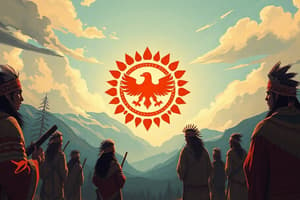Podcast
Questions and Answers
Which of the following groups are recognized as Aboriginal peoples in Canada? (Select all that apply)
Which of the following groups are recognized as Aboriginal peoples in Canada? (Select all that apply)
- Newfoundlanders
- First Nations (correct)
- Métis (correct)
- Inuit (correct)
Treaties in Canada are only considered valid if both parties agree to them every year.
Treaties in Canada are only considered valid if both parties agree to them every year.
False (B)
Name one of the five different linguistic groups of First Nations peoples in Manitoba.
Name one of the five different linguistic groups of First Nations peoples in Manitoba.
Anishinaabe. (Other valid answers include Cree, Dakota, Dene, and Ojibway.)
Indian Residential Schools aimed to assimilate Indigenous children to __________ culture.
Indian Residential Schools aimed to assimilate Indigenous children to __________ culture.
Match the following groups with their characteristics:
Match the following groups with their characteristics:
Flashcards
Aboriginal Peoples
Aboriginal Peoples
The descendants of the original inhabitants of North America.
Treaty
Treaty
A formal agreement between two parties, in Canada it's between Canada and First Nations.
Indian Residential Schools
Indian Residential Schools
Schools that aimed to integrate Indigenous children into Western culture, Christianity, and eradicate their own cultures.
The Crown
The Crown
Signup and view all the flashcards
Reserve Land
Reserve Land
Signup and view all the flashcards
Study Notes
Aboriginal Peoples
- Aboriginal peoples are the descendants of the original inhabitants of North America
- The Canadian Constitution recognizes 3 groups: Indian (First Nations), Metis, and Inuit
- Aboriginal peoples live in rural and urban areas, and on reserve land
- Reserves are land set aside by the Canadian government for First Nations, having different rules than other Canadian land.
Linguistic Groups in Manitoba
- Manitoba has 5 First Nations linguistic groups with unique histories and cultures: Anishinaabe (Ojibway), Anishininiwak (Oji-Cree), Dakota, Dene, and Nehowak/ininiwak (Cree).
Treaties
- Treaties are solemn agreements between Canada (the Crown) and First Nations
- Treaties are in effect as long as the sun shines, the grass grows, and rivers flow
Residential Schools
- Residential schools were established (1831), and later sponsored by the Canadian government (1883)
- The schools aimed to assimilate Indigenous children into Western culture (especially Christian values and European culture) and suppress Indigenous languages and cultures.
- They were run by churches initially, then by the Canadian government
- In Manitoba, there were 14-18 residential schools, and the last school closed in 1996
- Total Canadian residential schools: 139
- The Canadian government and mostly Christian churches (primarily Roman Catholic) funded these schools.
- Children were forced to attend these schools from the 1890s to the 1950s
- "Indian Agents," white men working for the Department of Indian Affairs, ensured attendance by children, to carry out government policy.
Studying That Suits You
Use AI to generate personalized quizzes and flashcards to suit your learning preferences.




